AWS Getting Started Guide
Aviatrix provides a product launch experience with automation and a simple UI guided flow to make it easy for you to begin using the product.
Prerequisites
Ensure you have enough VPCs, gateways, and elastic IPs available for deployment in your AWS region.
See Preparing for Your AWS Deployment for pre-deployment considerations.
AWS Simple Product Launch Overview
The launch experience is currently available for AWS at launch.aviatrix.com. The launch experience automates the following:
-
Creation of a VPC for Controller and CoPilot (or you can select an existing VPC)
-
Deployment and configuration of IAM
-
Deployment of Controller and CoPilot into the newly created VPC
-
Creation of security groups securing platform access to only your IP
-
Initialization of Controller and CoPilot to current version
-
Configuration and integration between Controller and CoPilot
|
The entire process completes in about 15 minutes when orchestrated with CloudFormation. |
The guided flow involves four simple steps. The details for each step are outlined in Launch Step Details.
Step 1: Aviatrix License
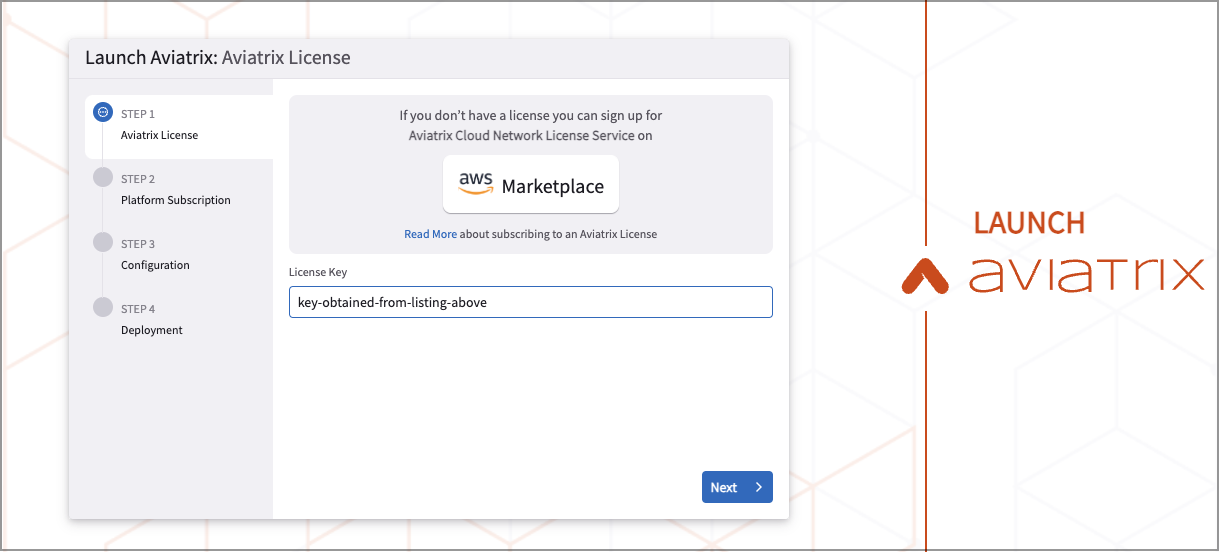
Step 2: Platform Subscription
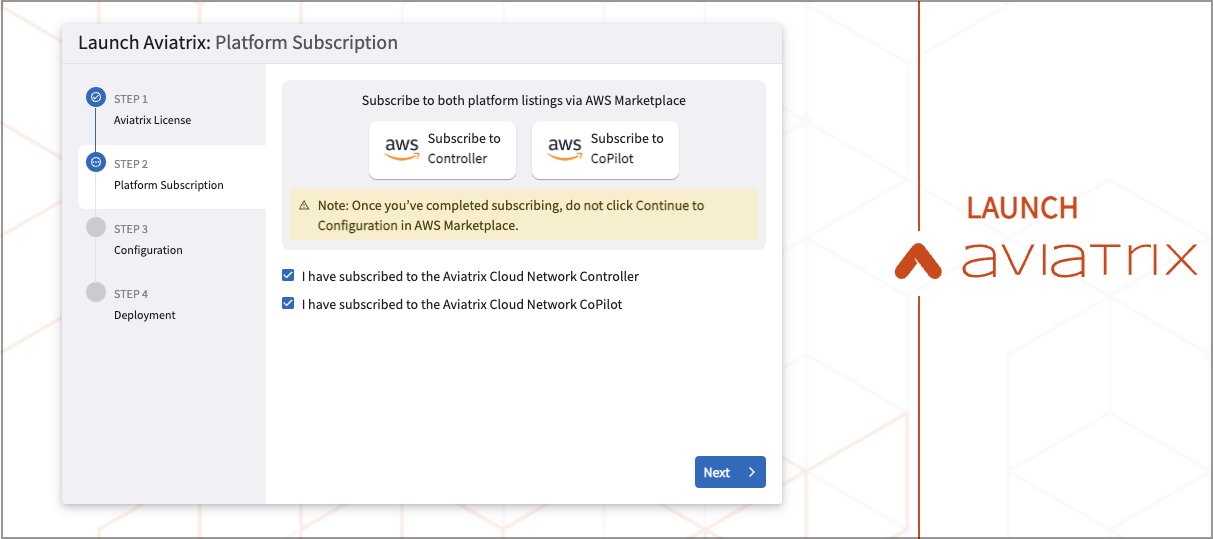
Step 3: Configuration
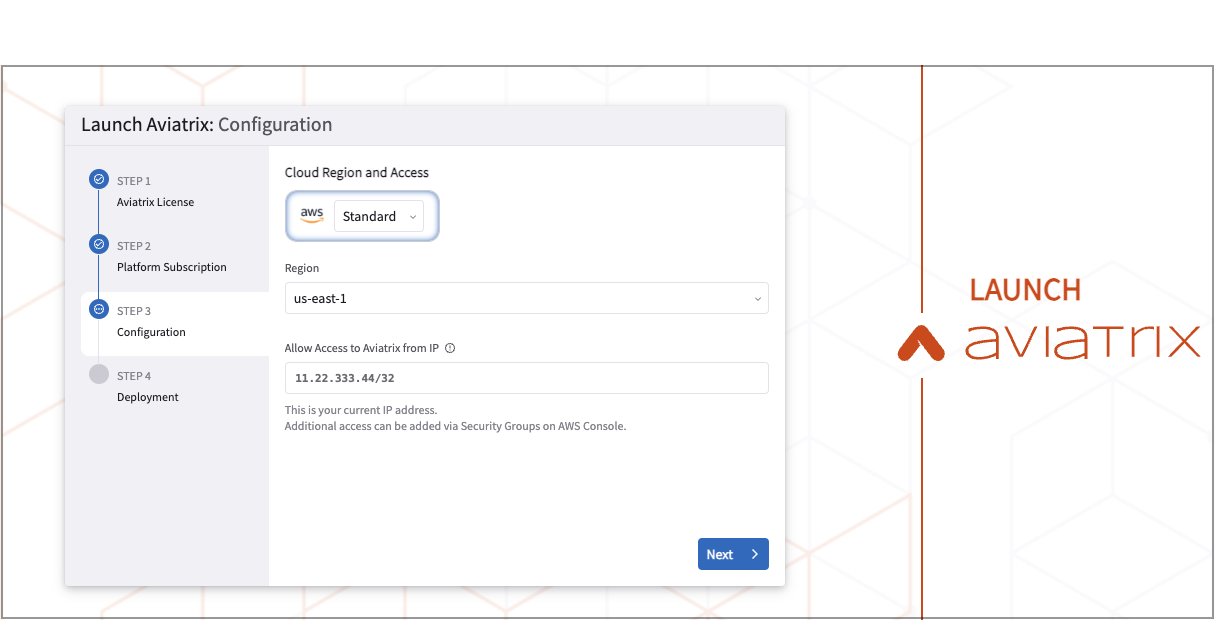
Step 4: Deployment
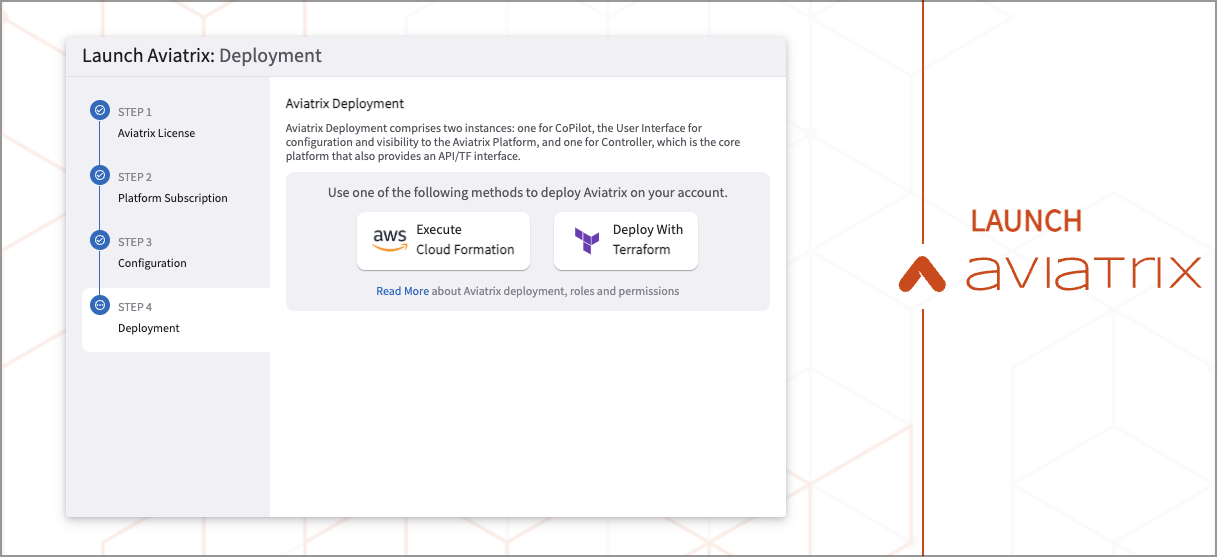
Log in to CoPilot
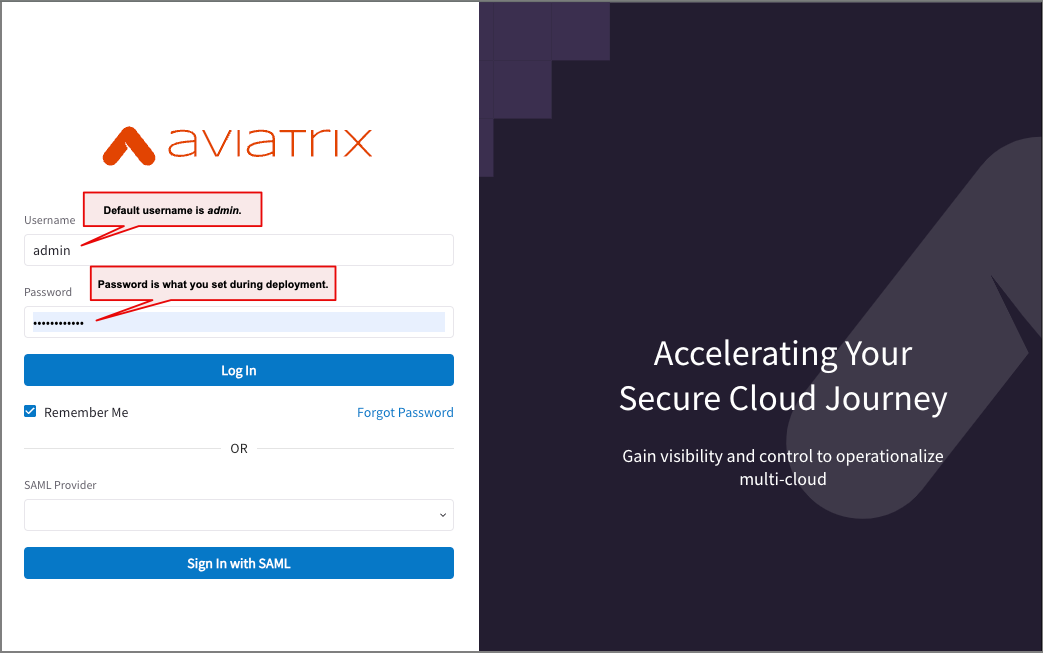
The default username is admin, and the password is what you entered in the CloudFormation template.
Required Aviatrix License and Marketplace Offers
Three Marketplace subscriptions are required to deploy the Aviatrix platform. You will subscribe to these offerings by accessing the Launch Aviatrix guided experience.
| License or Offer | Description |
|---|---|
Aviatrix Enterprise Contract |
The Aviatrix Enterprise Contract listing provides the license (customer-id) required to active the Aviatrix Cloud Network Controller and Aviatrix Cloud Network CoPilot. A free trial is available with this AWS offer. When the free trial expires, the customer must upgrade to one of the paid options in the listing. |
Aviatrix Cloud Network Controller |
This Bring Your Own License (BYOL) offer integrates with the Aviatrix license. |
Aviatrix Cloud Network CoPilot |
This Bring Your Own License (BYOL) offer integrates with the Aviatrix license. |
|
If you subscribe to the free trial license, you receive notification emails 14, 7, and 1 day before the free trial expires and billing begins. |
Launch Step Details
The Aviatrix launch experience guides you through a quick configuration process to get the Aviatrix Cloud Networking Platform up and running in your AWS environment.
You can access the Aviatrix launch experience from launch.aviatrix.com.
| Do not click the browser refresh or back buttons while using Launch Aviatrix. To go back to a previous page, click on a Step in the Launch navigation. |
Step 1: Register an Aviatrix License
-
In the Launch Aviatrix licensing window, do one of the following:
-
If you need a license, click AWS Marketplace to open the Marketplace listing in a separate tab and continue to the next step.
-
If you already have a license, enter the key in the License Key field and skip to Platform Subscription.
You received the key in an email when you originally registered. The key is not retained anywhere else. If you do not have the key, contact your account manager.
-
-
On the Marketplace page, click Try for free.

-
On Configure your Software Contract, under Purchase click Subscribe to free trial, and then click Set up your account.
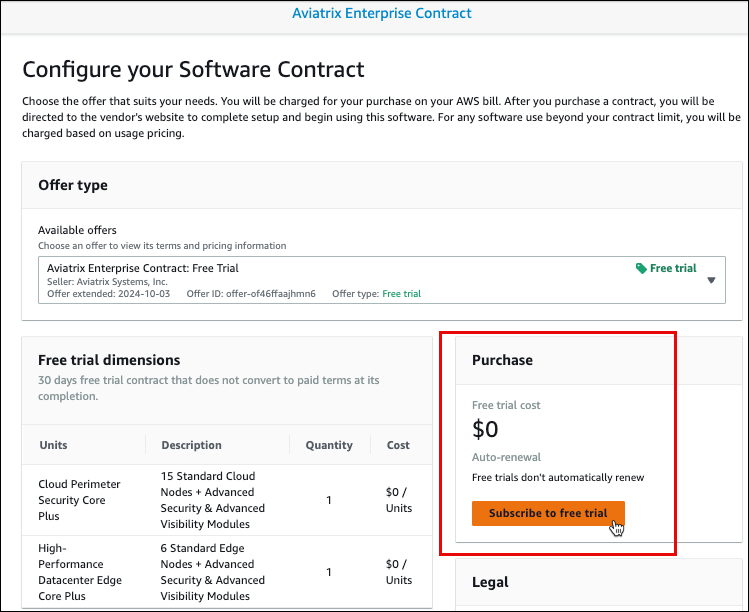
You will be redirected back to the Launch Aviatrix window.
-
Enter your business email address and click Verify Email.
An email is sent to you from launch@email.aviatrix.com with the subject line "Verify Your Identity," that contains a verification code.
-
Copy the code from the email, enter it in the field in Launch Aviatrix, and then click Next.
A success page displays and shows your unique license key. This key and subscription ID are also emailed to you.
This license key is not available anywhere else. Save the key and subscription ID in a safe place. You need them in the future. -
Click Next.
Step 2: Platform Subscription
Subscribe to Aviatrix Cloud Network Controller and Aviatrix Cloud Network CoPilot.
-
Click Subscribe to Controller.
The AWS Marketplace listing opens on a separate tab.
-
On the Marketplace page, click Continue to Subscribe.
-
On the subscription page, click Accept Terms.
Your subscription is submitted and Pending displays in the table on this page. You can continue to the next step while the subscription process completes, which takes about a minute.
Do not click Continue to Configuration in AWS Marketplace. -
Return to Launch Aviatrix and click Subscribe to CoPilot.
-
On the Marketplace page, click Continue to Subscribe.
-
On the subscription page, click Accept Terms.
Your subscription is submitted and Pending displays in the table on this page. You can continue to the next step while the subscription process completes, which takes about a minute.
Do not click Continue to Configuration. -
Return to Launch Aviatrix and check both boxes indicating you subscribed to Controller and CoPilot.
-
Click Next.
Step 3: Configuration
-
Select the AWS region for deployment.
-
Select whether an existing VPC or a new VPC should be used for deployment.
If you choose an existing VPC, then during deployment you will be able to select which VPC to use.
If you choose a new VPC, the VPC is automatically created for you during deployment.
-
Click Next.
|
An IP address populates automatically based on your client IP. The /32 is appended to the address to ensure that only the IP that initiated provisioning can initially access the Controller and CoPilot UIs. You can change the IP address after provisioning is complete, by modifying AWS Security Groups. |
Step 4: Deployment
-
Select the configuration method for the deployment, either CloudFormation or Terraform.
The automated CloudFormation method is recommended over the manual Terraform method.
Launch the Stack with CloudFormation
You can subscribe to the Aviatrix platform and launch the Aviatrix stack directly from the Aviatrix launch experience at launch aviatrix.com.
It is recommended you use the default settings in the CloudFormation template. You can modify other settings after deployment. Only the following input is required:
-
VPC CIDR, if you are using an existing VPC
-
Subnet Availability Zone and CIDR, if you are using an existing VPC
-
Administrator password
| Ensure you have at least 1 VPC, 1 gateway, and two elastic IPs (EIPs) available in the AWS region you are deploying to. If these are not available, the deployment will fail. |
| The IP address pre-populated in the IPv4 CIDR field, under Connection Configuration, is the IP you are currently using. The /32 is appended to the address to ensure that only this user can initially access the Controller. You can add more users later in CoPilot. |
To deploy by using CloudFormation, perform the following steps in Launch Aviatrix.
-
In Step 4: Deployment in Launch Aviatrix, click Execute CloudFormation to open the AWS Quick create stack template.
-
If you chose to use an existing VPC for deployment, do the following:
-
Scroll to the VPC CIDR field and enter a VPC name.
You can get this information from your AWS VPC dashboard.
-
Choose a Subnet Availability Zone and enter a Subnet CIDR within the selected VPC.
-
-
Scroll to Administrator Password and Confirm Administrator Password fields and enter a password.

Password requirements: minimum 8 characters with at least 1 upper case, 1 lower case, 1 special character, and 1 number.
This is the password you will use to log in to the CoPilot and Controller UIs. The default username is admin.
-
Scroll to the Capabilities section at the bottom of the Template and check the box, "I acknowledge that AWS CloudFormation might create IAM resources."
-
Click Create Stack to run CloudFormation.
A browser tab opens to the AWS CloudFormation > Stacks page for your stack.
If nothing happens when you click Create Stack, scroll through the AWS CloudFormation template to check for error messages. -
To monitor the progress of the stack creation in AWS, see Monitor the CloudFormation Stack.

|
It takes about 15 minutes for the stack creation to complete. |
After the CloudFormation stack is created, you can access your CoPilot instance.
Deploy with Terraform
You can deploy Aviatrix by using Terraform, directly from the Aviatrix launch experience at launch aviatrix.com.
| Ensure you have at least 1 VPC, 1 gateway, and two elastic IPs (EIPs) available in the AWS region you are deploying to. If these are not available, the deployment will fail. |
You should be familiar with Terraform modules to use this method. If you choose to deploy with Terraform, you must meet the following prerequisites:
-
Install Boto3.
-
Configure authentication for AWS.
-
Install a minimum version of Terraform 0.13 and Python3.
To deploy by using Terraform, perform the following steps in Launch Aviatrix.
-
In Step 4: Deployment of Launch Aviatrix, click Deploy with Terraform.
-
Ensure you have met all the prerequisites.
-
Click Download Terraform Configuration File and save the file to an appropriate directory.
A Terraform file named avx-launch.tf downloads.
It is recommended that you install the Terraform modules in a separate directory from the rest of your Terraform pipeline.
-
In the directory where you saved the TF file, run the following commands:
terraform init terraform plan terraform apply
Enter a vpc_id from an existing or new VPC.
Enter a public subnet_id within the selected VPC. You can get this information from your AWS VPC dashboard.
-
To monitor the progress of the stack creation, see Monitor the CloudFormation Stack.

After the CloudFormation stack is created, you can access your CoPilot instance.
Advanced Terraform configurations can be implemented using the examples provided in the GitHub repository.
Monitor the CloudFormation Stack
You can monitor CloudFormation progress from the AWS CloudFormation console.
The CloudFormation page in AWS should automatically launch after you submit the CloudFormation or Terraform templates.
-
If not logged into AWS, log into your account in the target region and go to CloudFormation > Stacks.
-
Select the name of the stack being created and then click the Resources tab.
The default stack name is AviatrixControlplane.
Use the Refresh button to show more frequent updates to the table. -
Scroll through the Resources table to locate the AviatrixPlatformInitStepFunction entry and click on the associated Physical ID link.
It takes about two minutes for the step function entry to display in the table.
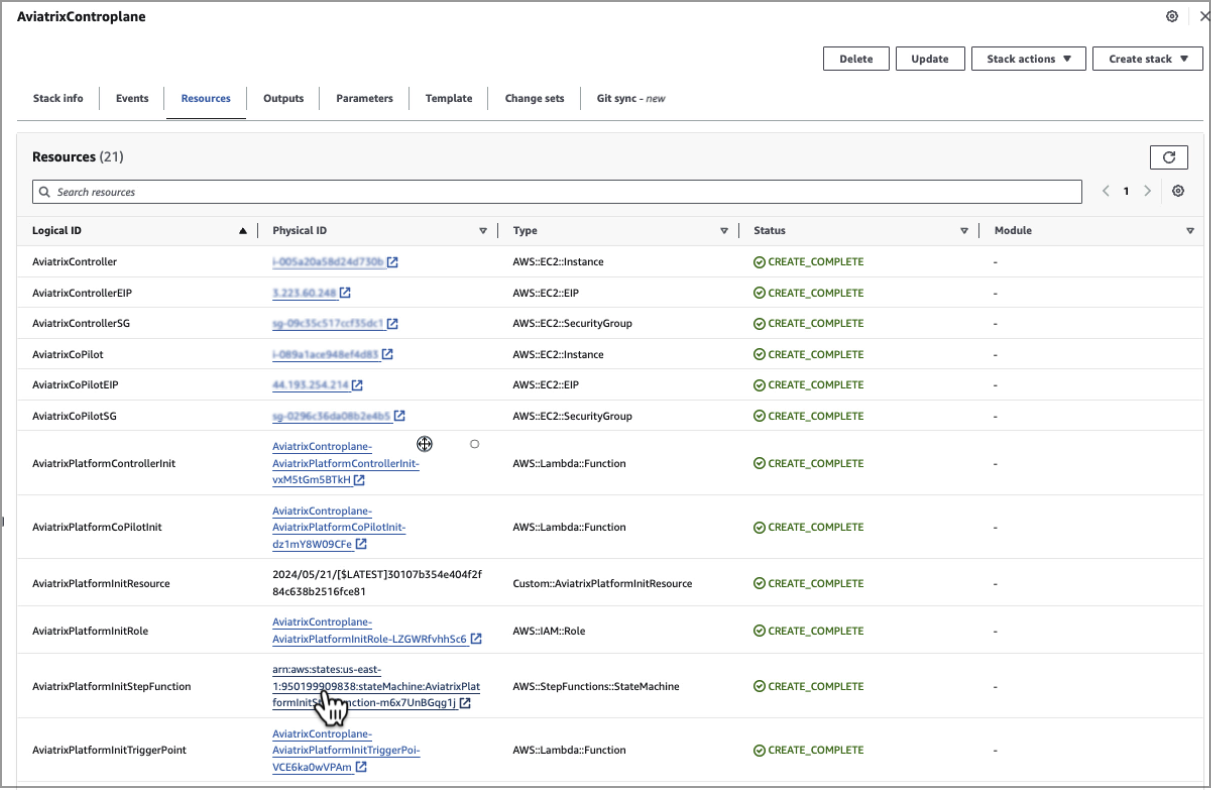
-
On the step functions page, click the Executions tab, and then click the link in the table for the running task.
-
Under Graph View, you can watch the progress of each step. Wait until all steps turn green.
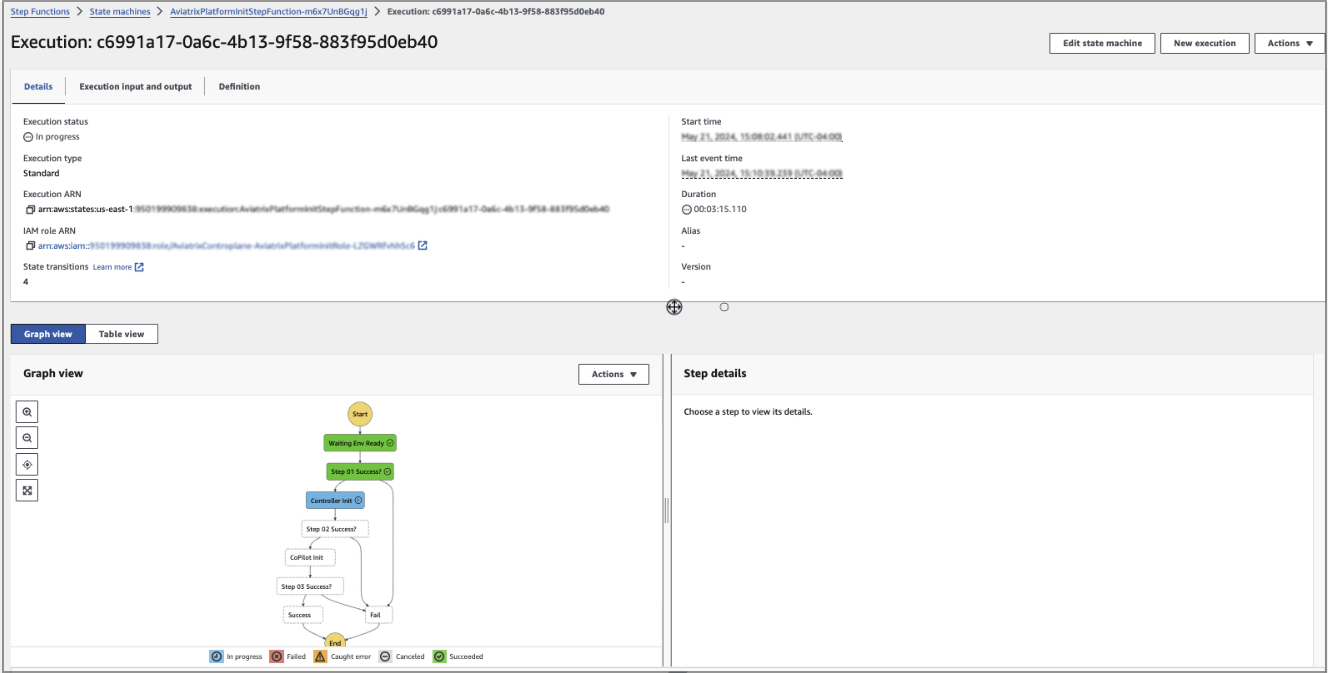

When all steps are green, the process is complete. This typically takes about 15 minutes.
You can now access your CoPilot instance.
Access the CoPilot UI
Congratulations! You have successfully launched your Aviatrix platform.
You can obtain the CoPilot UI URL in AWS.
-
Go to CloudFormation > Stacks > <stack name> and click the Outputs tab.
The default stack name is AviatrixControlplane.
-
Scroll down to locate AviatrixCoPilotURL in the Key column and click the associated link under Value.
The address displayed in the table is the one you will use to access CoPilot.

If the browser displays a Your connection is not private message, click Advanced and Proceed.
-
Enter the username and the password you defined in CloudFormation and click Log In to open the CoPilot UI.
The default username for the UI is admin, and the password is what you entered in the CloudFormation Quick Create template.
-
In CoPilot, you can access Controller by clicking the Application Information icon at the top right and selecting Aviatrix Controller.
You can use the CoPilot credentials to log in to Controller.
Access the Controller UI
You can access Aviatrix Controller from the CoPilot UI.
By default, the credentials are the same for CoPilot and Controller.
-
Log into your Aviatrix CoPilot account.
-
Click the Application Information icon in the top right.
-
Select the Aviatrix Controller IP address.
-
Enter your username and password to log into the Controller.
Troubleshooting if Stack Creation Fails
-
In AWS CloudFormation > Stacks, select the stack, select the Events tab, and examine the Status reason column for a possible cause.
-
Ensure that you are subscribed to required marketplace subscriptions.
-
If you have run the stack more than once, ensure that a unique new name is provided for the stack name. The default is AviatrixControlplane.
-
Ensure your AWS region has at least 1 VPC, 1 gateway, and 2 elastic IPs (EIPs) available for deployment.
Optional Post-Deployment Steps
Complete the following optional post-deployment steps if they meet your requirements.
Modifying Accidental Termination for AWS Instances
You can enable or disable the AWS option to protect against accidental termination of your EC2 instances. You cannot terminate an instance if termination protection is enabled.
-
In your AWS account, go to the EC2 > Instances page.
-
Locate and mark the checkbox for your Aviatrix Controller or CoPilot instance.
You can only modify the Instance Settings for one instance at a time. If you select multiple instances, the menu items under Instance Settings are not available.
-
Go to Actions > Instance Settings > Change termination protection.
-
Check Enable or Disable and click Save.
-
Repeat these steps for other instances.
Disabling Security Group Management Access
Security Group Management is enabled by default. This feature ensures that newly created gateways can access the Controller. You can disable Security Group Management access for your Controller, if needed.
|
When this feature is enabled, keep each Controller Security Group’s outbound rules at their default, open to Internet or All. This allows your Controller’s IP address to access the Internet. |
-
In Aviatrix CoPilot, go to Settings > Configuration.
-
Under Security, locate the Controller Security Group Management card.
-
Select the Controller Account.
-
Set the toggle to Off.